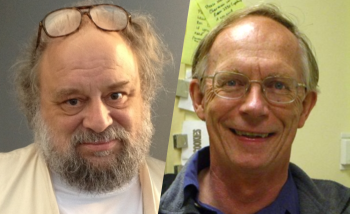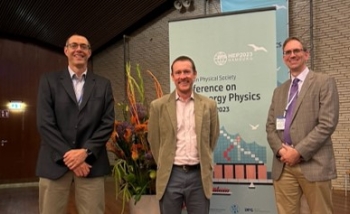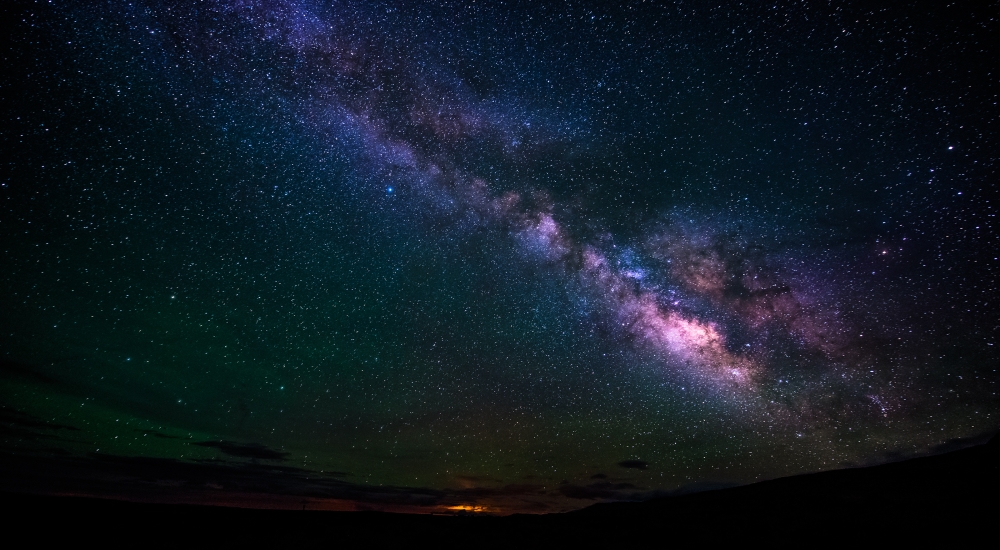For their game-changing contributions to the hunt for distant explosions called fast radio bursts, the Canadian Hydrogen Intensity Mapping Experiment (CHIME) Collaboration – including Perimeter’s Kendrick Smith and Ue-Li Pen – have been awarded the Brockhouse Canada Prize for Interdisciplinary Research in Science and Engineering.
The prize citation describes the CHIME collaboration as “truly one of the biggest success stories in Canadian astrophysics,” and lauds the team for uncovering “profound new knowledge about some of the greatest mysteries of our universe.”
Awarded annually by the Natural Sciences and Engineering Research Council of Canada (NSERC), the Brockhouse Canada Prize recognizes outstanding Canadian teams who combine expertise from different disciplines to achieve advances in the natural sciences and engineering. It is named after Nobel-winning Canadian physicist Bertram Brockhouse.
While the 2022 prize citation lists 12 of CHIME’s leading researchers, the CHIME collaboration is truly a team effort. This stellar team includes Smith, who holds the Daniel Family James Peebles Chair at Perimeter, and Pen, an associate faculty member at Perimeter and a professor at the Canadian Institute for Theoretical Astrophysics at the University of Toronto, as well as other researchers at Perimeter.
Fast radio bursts are bright flashes of light, registering in the radio band of the electromagnetic spectrum, that blaze for a few milliseconds before vanishing without a trace. Their origins are unknown, their appearance is unpredictable, and their detection was rare until the CHIME-FRB collaboration began its hunt.
Beginning in 2007, only a few dozen had been detected before CHIME began operations in 2018. Nestled in a valley of Penticton, BC – far from interfering human-made signals – CHIME has become a powerhouse in FRB detection, finding 535 new fast radio bursts during its first year of operation and more than 1,000 to date.
“The CHIME telescope has become the most successful FRB hunter in the world by turning a hardware problem into a software problem,” says Smith. “CHIME generates 1,000 times more data than a traditional radio telescope. The dataset looked computationally impossible until algorithmic breakthroughs made by the Perimeter team. It’s been both incredibly challenging and incredibly rewarding to be part of this made-in-Canada astrophysical success story.”
The team has since discovered bursts that fall in two distinct classes: those that repeat, and those that don’t. The team identified 18 FRB sources that burst repeatedly, while the rest appear to be one-offs. The repeaters also look different, with each burst lasting slightly longer and emitting more focused radio frequencies than bursts from single, non-repeating FRBs.
The prize citation reads: “Together, this powerful collaboration of experts has designed and built one of the most novel and extraordinarily powerful radio telescopes in the world. Unlike traditional telescopes that mechanically point to and observe a small region of the sky, this revolutionary technology forms an image of the entire overhead sky each day by digitally processing the information received on a compact array of 2048 radio receivers as the Earth rotates.”
The award also recognizes the CHIME team for creating a “progressive training environment for students, postdoctoral fellows, and research associates,” including members of underrepresented groups in physics. In total, CHIME involves more than 50 scientists from Canadian institutions – including Perimeter, McGill University, the University of British Columbia, the University of Toronto, and the National Research Council of Canada (NRC) – and universities in the US and abroad.
“The CHIME team is an exemplar of the kind of collaborative, interdisciplinary research that is driving many of the most consequential advances in physics today,” says Perimeter Director Robert Myers.
“CHIME has vaulted Canada to the forefront of radio astronomy, opening new avenues to learn fundamental truths about our universe. We are immensely proud of the critical role that Kendrick Smith, Ue-Li Pen, and other Perimeter researchers have played in CHIME’s success.”
There is much more excitement on the horizon, says Smith. The CHIME/FRB Collaboration will soon be adding outrigger telescopes in British Columbia, California, and West Virginia that will increase CHIME’s resolution and allow observers to more easily determine the host galaxy of a given burst.
Plans are also underway for the construction of the CHORD telescope (Canadian Hydrogen Observatory and Radio-transient Detector) over the next several years, which will be adjacent to (and roughly eight times more powerful than) CHIME.
“If you’re interested in FRBs, Canada is the place to be right now,” says Smith.
About PI
Perimeter Institute is the world’s largest research hub devoted to theoretical physics. The independent Institute was founded in 1999 to foster breakthroughs in the fundamental understanding of our universe, from the smallest particles to the entire cosmos. Research at Perimeter is motivated by the understanding that fundamental science advances human knowledge and catalyzes innovation, and that today’s theoretical physics is tomorrow’s technology. Located in the Region of Waterloo, the not-for-profit Institute is a unique public-private endeavour, including the Governments of Ontario and Canada, that enables cutting-edge research, trains the next generation of scientific pioneers, and shares the power of physics through award-winning educational outreach and public engagement.
You might be interested in



